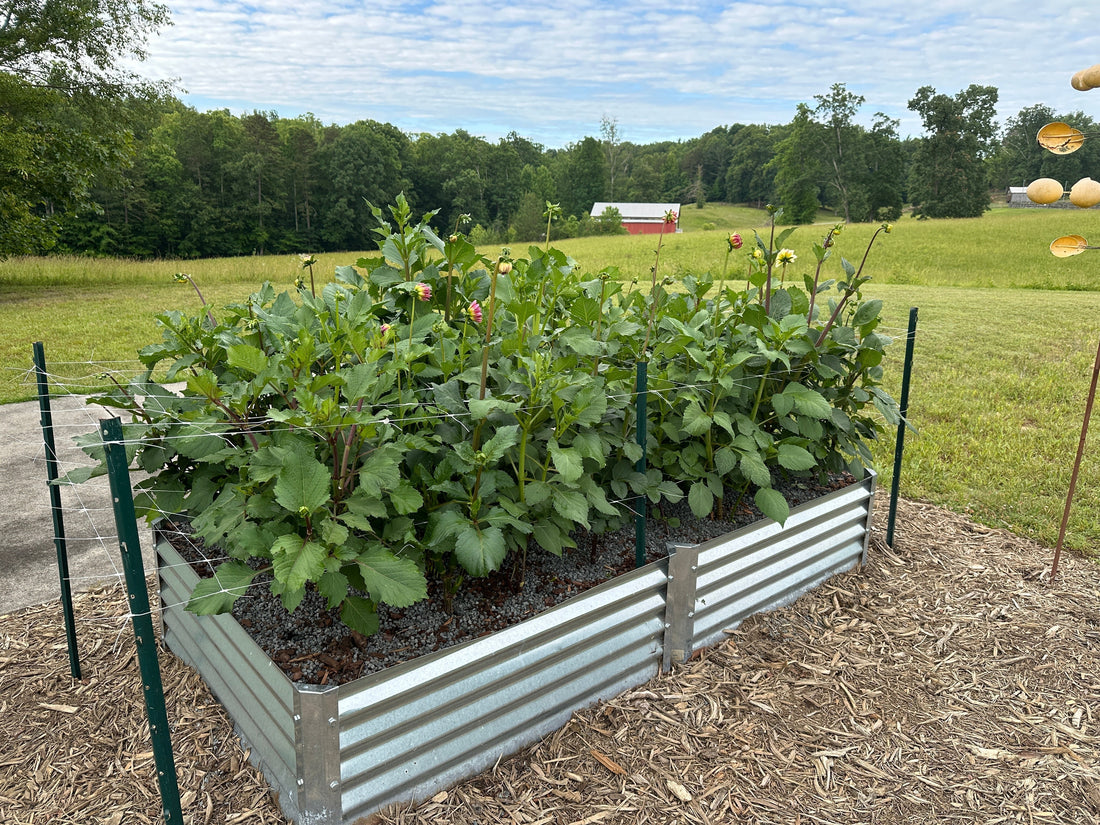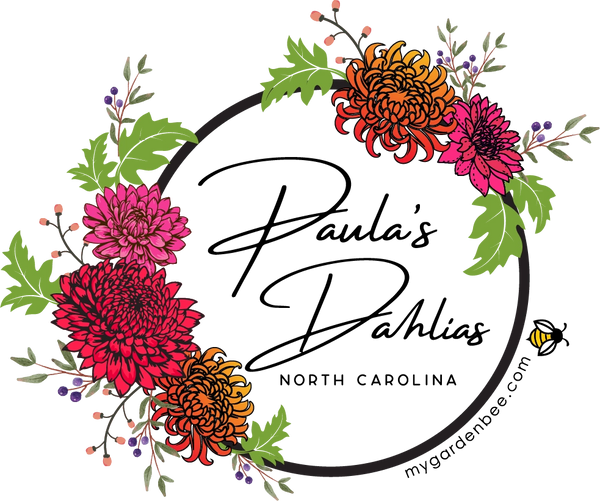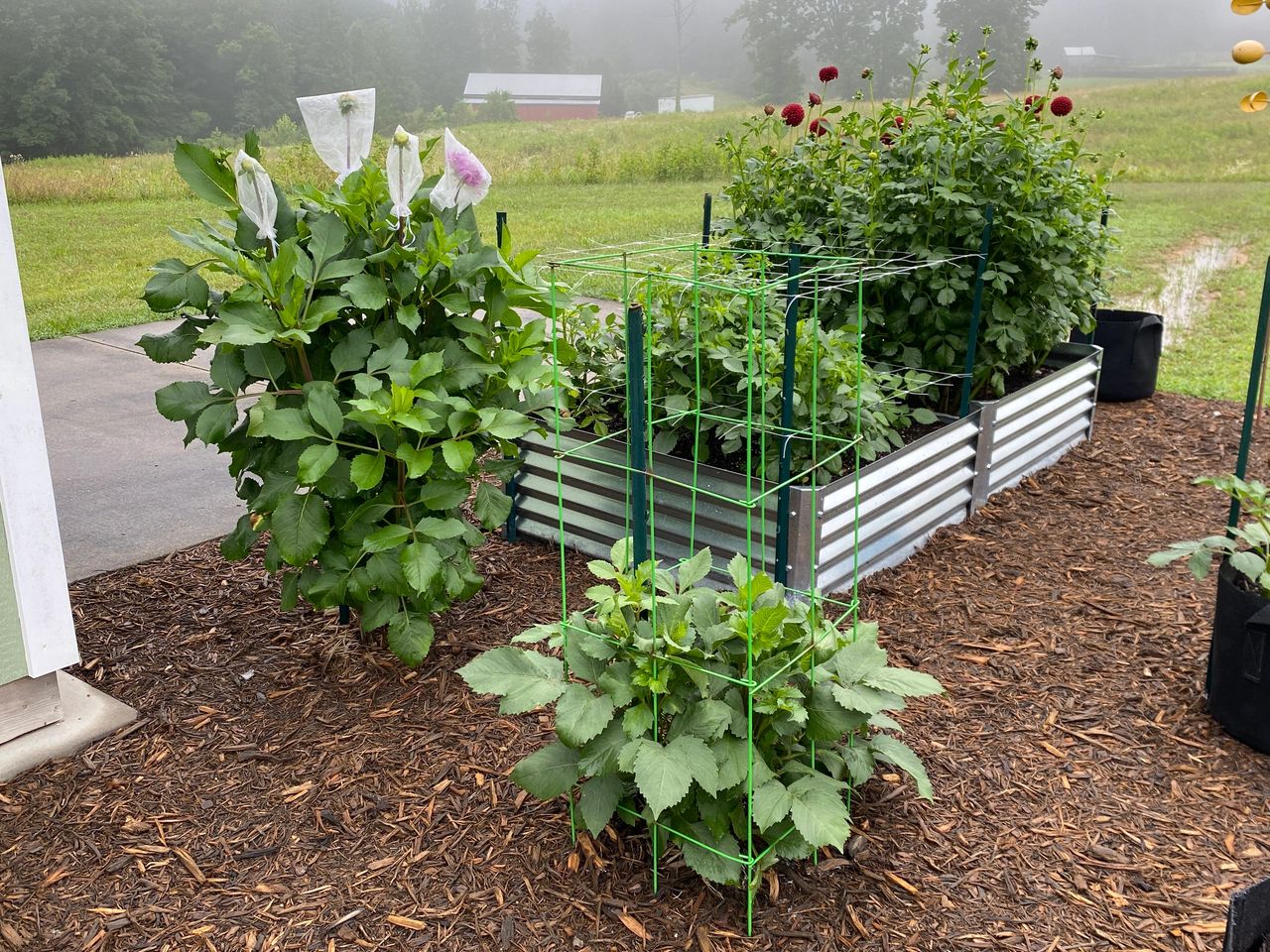
Growing Dahlias in Raised Beds
Planting dahlias in a raised bed is a great way to grow dahlias. If you live in an area that receives a lot of rain or is prone to flooding or if your soil does not drain well or holds water, you may want to consider building a raised bed for your dahlia garden. You can build one yourself or purchase one online. I purchased a couple of metal raised beds online. They were easy to put together. You can fill the bottom of your raised beds with small tree branches or sticks and then add some leaves. You could use maple, willow, and oak. I have read where you should avoid trees like black walnut, sycamore, black cherry, or black locust. The initial filling up the raised bed requires the most effort. Each year afterwards, you will only need to add some fresh compost, raised bed soil, fertilizer, and top with a little mulch if you wish.
I use bags of compost, soil conditioner, and a good quality potting mix on top of the leaves and tree branches. My local home improvement carries raised bed soil, so I use that product. I also put an aged pine bark soil conditioner on top as a mulch. My county extension office recommends pine bark for improving soil, especially clay soil. It breaks down over time and provides organic matter. Organic matter provides nutrients and a habitat for organisms living in the soil. Organic matter improves the water holding capacity of the soil, reduces compaction, and reduces the soil surface becoming crusty and hard.

Growing dahlias in a raised bed offers better growing conditions as you can provide good quality growing mixture to the raised bed. The plant roots can breathe. You could make your own soil mix by adding equal parts of sphagnum peat moss, vermiculite, perlite, and compost. You may want to add fertilizer to that mixture. If you are reusing a raised bed, it would be a good idea to do a soil test every 2 or 3 years to make sure you are adding the proper amendments.
My metal raised beds are 6 feet 8 inches x 3 feet 4 inches and 17 inches tall. I can plant 12 to 16 dahlias in this bed. They are around 12" to 18" apart. We built some wood raised beds around my house. You want the raised beds to be at least 12" tall for planting dahlias as you are planting dahlia tubers at around 5" to 6" deep.
For support, I use hortonova netting. I use 4-foot metal U-posts that I purchase from my local home improvement store. I have 2 sets of hortonova netting on the raised bed. I adjust the height, as necessary. Some dahlias grow tall so you may need a 6-foot metal post.
We do add 1/4-inch x 1/4-inch hardware cloth underneath the raised beds to keep voles and other pests from digging up from the bottom of the raised bed. The hardware cloth comes in 25-foot rolls. You should be able to find it at your local hardware or home improvement store. I did purchase a 3 foot x 25 foot roll at Amazon. Here is a link. (I may earn a small commission over time from qualifying purchases as an Amazon Associate.)
We placed that on the ground and placed the raised bed on top of the hardware cloth. We pinned it down. This stopped the voles from digging into the raised bed from the bottom.

If you are using stakes or a trellis, you would need to tie the plants about every 12” to 18” using baling twine or plastic ties. Make sure you do not tie them too tight as you will damage the stalks.
When growing dahlias in a raised bed, do not forget to water if necessary. Dahlias need 1" of watering a week. In my plant hardiness zone 7 area, I water my dahlias weekly if we do not receive any rain. When we have over 93-degree weather, I mist the dahlias once or twice in the hot afternoons to cool them down. You could use drip irrigation with one line in the front of the bed and the other line in the back of the bed. The drip lines would go along the edge of the dahlias. I have drip irrigation in my dahlia field. I do not mind watering the raised beds a couple times a week with a water hose. It allows me to take a moment and see how they are doing as I am usually busy out in the dahlia field.
I add an organic fertilizer like Espoma Plant Tone at planting time. Espoma Plant Tone has 5% nitrogen, 3% phosphorus, 3% potassium, and has calcium magnesium, and sulfur. I mix that fertilizer in the top one inch of soil after I plant the dahlia tuber. I do fertilize the dahlias in the raised beds every 3 to 4 weeks with a liquid fertilizer called Vigor Plant Booster. Vigor Plant Booster is a soil conditioner and fertilizer made from cool processed whole fish & deep-water kelp enhanced with 70 trace elements. Vigor has 9% nitrogen, 2% phosphorus, and 6% potassium. It also contains Sulphur, calcium, magnesium, boron, copper, iron, manganese, zinc, selenium, cobalt, and carbon. Vigor Plant Booster was created by Warren Vigor who is a champion dahlia grower. This product has made his dahlia blooms stand out at dahlia exhibition shows. You can find more information at vigorfertilizer.com. You could use a similar fish/seaweed organic fertilizer. If you do not have time to worry about fertilizing throughout the dahlia season, try to fertilize when planting the dahlia. I do see a difference in my dahlia’s performance with fertilization.
I am using Permatill to help deal with the voles coming into my dahlia field and eating the dahlia tubers. Permatill is a brand name for a type of expanded slate soil amendment. Expanded slate is a lightweight and porous material made from natural slate that undergoes a process of expansion at high temperatures. Permatill is used in gardening and landscaping to improve soil structure aeration, and drainage. Stalite Environmental in Salisbury, NC produces this product. I purchase it at my local hardware and gardening store. Permatill helps discourages voles because voles do not like to dig through materials that are coarse in texture. I mix the Permatill into my soil as I plant dahlias in the ground. For my raised beds, I do mix in some Permatill to help improve the overall mixture. I also use it as a mulch at the soil surface as it can help to reduce soil borne diseases on the stems and foliage. Also, slugs do not like to crawl on Permatill.
The dahlias will begin to bloom in the summer and all the way to frost. To have a bushier dahlia with more blooms, I pinch the center tip once the dahlia has five sets of true leaves. I leave four sets of leaves. This is a one-time pinch. Once they bloom, cut that first bloom, and take it inside your house to enjoy. The sooner you cut the first bloom, the sooner you will have more blooms to enjoy. Dahlias grow well in raised beds. In August, I do remove older bottom leaves to improve air flow. I remove more bottom leaves in September.

You can overwinter your dahlias in zones 7 and higher but I am not sure how they would make out in a raised bed since the tubers are above the ground. We can have cold winters in my northern North Carolina location so I do dig up my dahlias and store them over the winter in a cool location under 50 degrees. The tubers looked great when I removed them from the raised beds in late fall after we had a frost.
I do label my dahlias when I plant them. These labels are helpful when I dig the tubers in the fall to keep each dahlia variety together. I use tree tag labels that I purchase on Amazon. You can attach them to your stake or netting. You can also attached them around the dahlia once it starts growing. They last all season for me. Here is a link to the tree tag labels. (I may earn a small commission over time from qualifying purchases as an Amazon Associate.)
I have 5 raised beds that I grow dahlias, and I love them. The mixture that they grow in is so light and fluffy so they can easily produced tubers. I do plant 5 to 6 inches deep so that the dahlia will produce more tubers as the leaf nodes under the soil will produce roots that develop into tubers. If you are having issues growing dahlias in the ground, you may want to try raised beds.



